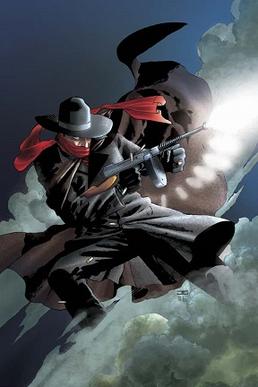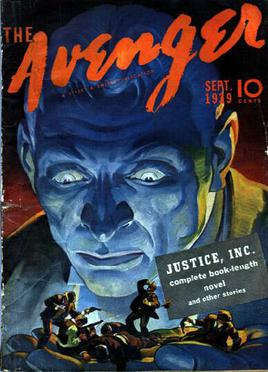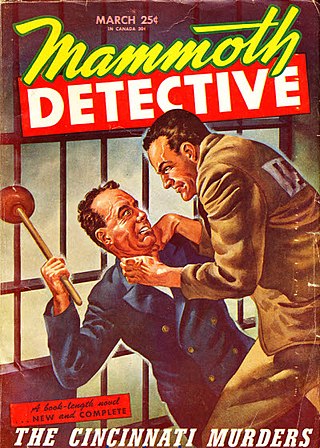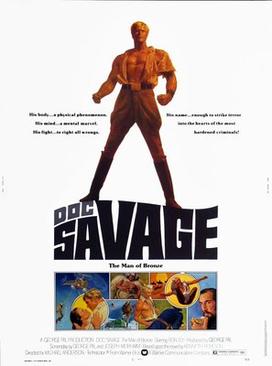Related Research Articles
Pulp magazines were inexpensive fiction magazines that were published from 1896 to the late 1950s. The term "pulp" derives from the cheap wood pulp paper on which the magazines were printed. In contrast, magazines printed on higher-quality paper were called "glossies" or "slicks". The typical pulp magazine had 128 pages; it was 7 inches (18 cm) wide by 10 inches (25 cm) high, and 0.5 inches (1.3 cm) thick, with ragged, untrimmed edges. Pulps were the successors to the penny dreadfuls, dime novels, and short-fiction magazines of the 19th century.

Doc Savage is a fictional character of the competent man hero type, who first appeared in American pulp magazines during the 1930s and 1940s. Real name Clark Savage Jr., he is a doctor, scientist, adventurer, detective, and polymath who "rights wrongs and punishes evildoers." He was created by publisher Henry W. Ralston and editor John L. Nanovic at Street & Smith Publications, with additional material contributed by the series' main writer, Lester Dent. Doc Savage stories were published under the Kenneth Robeson name. The illustrations were by Walter Baumhofer, Paul Orban, Emery Clarke, Modest Stein, and Robert G. Harris.

The Shadow is a fictional character published in the United States of America by magazine publishers Street & Smith and writer Walter B. Gibson. Originally created to be a mysterious radio show narrator, and developed into a distinct literary character in 1931 by writer Walter B. Gibson, The Shadow has been adapted into other forms of media, including American comic books, comic strips, serials, video games, and at least five feature films. The radio drama included episodes voiced by Orson Welles.

Lester Dent was an American pulp-fiction writer, best known as the creator and main writer of the series of novels about the scientist and adventurer Doc Savage. The 159 Doc Savage novels that Dent wrote over 16 years were credited to the house name Kenneth Robeson.

The Avenger is a fictional character whose original adventures appeared between September 1939 and September 1942 in the pulp magazine The Avenger, published by Street & Smith, which ran 24 issues. Five additional short stories were published in Clues Detective magazine (1942–1943), and a sixth novelette in The Shadow magazine in 1943. Decades later, newly written pastiches were commissioned and published by Warner Brothers' Paperback Library from 1973 to 1974.
Lawrence Louis Donovan was an American pulp fiction writer who wrote nine Doc Savage novels under the pseudonym Kenneth Robeson, a pen name that was used by other writers of the same publishing house. However, there are nine Doc Savage novels duly credited to Donovan, published between November 1935 and July 1937.

William Gibson Bogart was an American pulp fiction writer. He is best known for writing several Doc Savage novels, under the pseudonym Kenneth Robeson.

Doc Savage: His Apocalyptic Life is a fictional biography by Philip José Farmer about pulp fiction hero Doc Savage.

Doc Savage: The Man of Bronze is a 1975 American action film starring Ron Ely as pulp hero Doc Savage. This was the last film completed by pioneering science fiction producer George Pal. It was directed by Michael Anderson, who had previously directed another big-budget adventure film, Around the World in 80 Days, the 1956 Best Picture of the Academy of Motion Picture Arts and Sciences.

William Murray is an American novelist, journalist, short story, and comic book writer. Much of his fiction has been published under pseudonyms. With artist Steve Ditko, he co-created the superhero Squirrel Girl.

Death in Silver is a Doc Savage pulp novel by Lester Dent writing under the house name Kenneth Robeson. It was published in October 1934.

Altus Press is a publisher of works primarily related to the pulp magazines from the 1910s to the 1950s.

Doc Savage was an American pulp magazine that was published from 1933 to 1949 by Street & Smith. It was launched as a follow-up to the success of The Shadow, a magazine Street & Smith had started in 1931, based around a single character. Doc Savage's lead character, Clark Savage, was a scientist and adventurer, rather than purely a detective. Lester Dent was hired to write the lead novels, almost all of which were published under the house name "Kenneth Robeson". A few dozen novels were ghost-written by other writers, hired either by Dent or by Street & Smith. The magazine was successful, but was shut down in 1949 as part of Street & Smith's decision to leave the pulp magazine field completely.

The Man of Bronze is a Doc Savage pulp novel by Lester Dent writing under the house name Kenneth Robeson. It was published in March 1933. It was the basis of the 1975 movie Doc Savage: The Man of Bronze starring Ron Ely.

The Nemesis of Evil is a science fiction novel by American writer Lin Carter, the first in his "Zarkon, Lord of the Unknown" series. It was first published in hardcover by Doubleday in 1975, with a paperback edition following from Popular Library in March 1978. It was reissued by Wildside Press in 1999. An ebook edition was issued by Thunderchild Publishing in August 2017.

The Earth-Shaker is a science fiction novel by American writer Lin Carter, the fourth in his "Zarkon, Lord of the Unknown" series. It was first published in hardcover by Doubleday in July 1982. An ebook edition was issued by Thunderchild Publishing in November 2017.

Invisible Death is a science fiction novel by American writer Lin Carter, the second his "Zarkon, Lord of the Unknown" series. It was first published in hardcover by Doubleday in November 1975, with a paperback edition following from Popular Library in July 1978. It was reissued by Wildside Press in December 1999. An ebook edition was issued by Thunderchild Publishing in September 2017.

The Volcano Ogre is a science fiction novel by American writer Lin Carter, the third his "Zarkon, Lord of the Unknown" series. It was first published in hardcover by Doubleday in 1976, with a paperback edition following from Popular Library in November 1978. It was reissued by Wildside Press in 1999. An ebook edition was issued by Thunderchild Publishing in October 2017.

Horror Wears Blue is a science fiction novel by American writer Lin Carter, the fifth and last in his "Zarkon, Lord of the Unknown" series. It was first published in hardcover by Doubleday in November 1987. An ebook edition was issued by Thunderchild Publishing in December 2017.
References
- 1 2 3 4 5 6 Dent, Lester (March 1933). "The Man of Bronze". Doc Savage Magazine. Street & Smith. 1 (1).
- 1 2 3 4 5 6 7 8 9 10 Farmer, Philip José (1973). Doc Savage: His Apocalyptic Life . PEI Books.
- 1 2 Dent, Lester; Davis, Harold A (October 1935). "Dust of Death". Doc Savage Magazine. Street & Smith. 6 (2).
- ↑ "The blonde was Lea Aster, Monk's secretary. Monk was wont to boast he had the prettiest secretary in New York, and he probably did not exaggerate." "The Red Skull", Bantam Edition, page 31.
- ↑ Dent, Lester (December 1933). "The Phantom City". Doc Savage Magazine. Street & Smith. 2 (4).
- ↑ "Long Tom, like Ham, had earned his nickname in France. In a certain French village there had been ensconced in the town park an old-fashioned cannon... In the heat of the enemy attack, Major Thomas J. Roberts had loaded this ancient relic with a sackful of kitchen cutlery and broken wine bottles, and wrought genuine havoc. And from that day, he was Long Tom Roberts." The Man of Bronze, Bantam edition, October 1964, p. 36.
- ↑ Dent, Lester (January 1934). "Brand of the Werewolf". Doc Savage Magazine. Street & Smith. 2 (5).
- ↑ "She [Pat] was a cousin, one of Doc's few living blood kin..." The Time Terror, Bantam edition, page 110.
- ↑ "The Laugh of Death", Bantam edition, page 14.
- ↑ "Brand of the Werewolf", Bantam edition, page 9.
- ↑ "Doc Savage was working shorthanded... Pat was not actually a member of their organization, but she was efficient, and lately Doc had taken to pressing her into service..." "The Fiery Menace", Bantam edition, page 147.
- ↑ "A cartridge belt was draped around her waist. From it dangled a heavy Frontier Single Action six-shooter..." "Brand of the Werewolf", Bantam edition, page 26.
- ↑ "Patricia Savage slid off the seat onto the floorboards, opening her chic hand bag as she did so. Out of the bag came an enormous, much-worn single-action six-shooter. The gun had neither trigger nor sights, and a fanning spur had been welded onto the hammer." "Fear Cay", Bantam edition, page 29.
- ↑ "the piece of artillery that my grandfather used to fight Indians with." "The Hate Genius" (formerly "Violent Night"), Bantam edition, page 104.
- ↑ Dent, Lester (January 1945). "Violent Night". Doc Savage. Street & Smith. 24 (5).
- ↑ I Died Yesterday, Doc Savage Omnibus 5, Bantam Books, 1988, p 407.
- ↑ Pat Savage: Six Scarlet Scorpions, Altus Press, 2016.